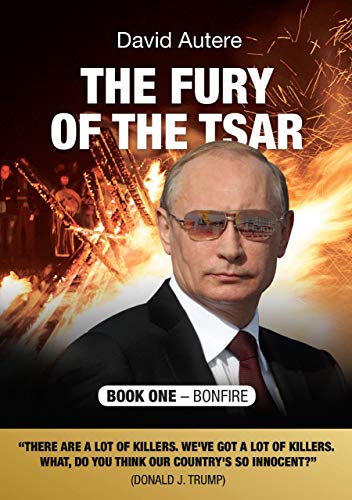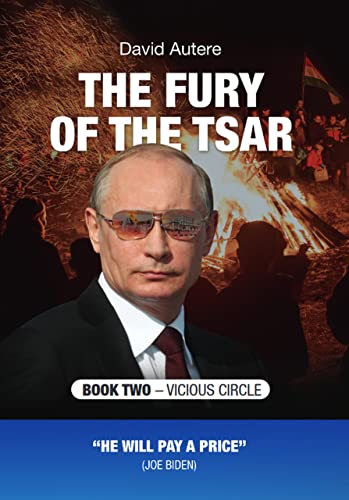The Fury of Tsar is an insightful geopolitical thriller covering global power politics, the mindset of Vladimir Putin and the dangers arising from Central and Southeastern European history.

It may resemble a fictional spy novel, but it is much more, leading the reader into the realm of American-Russian geopolitical competition; past and present battles of unimaginable cruelty fought behind the scenes. Written by Attila Demkó, a defense policy expert and former head of the Defense Policy Department of the Hungarian Ministry of Defense, who published under the pseudonym David Autere, it can also be considered a series of “what if” scenarios.
The author details facts that give readers a lot of information about important historical events in Europe. It was published in early 2018 in Hungarian under the title Máglyatűz, receiving rave reviews in the Hungarian press and became one of biggest bestsellers in Hungary of the last few years. The English edition was published in 2019 under the title Fury of the Tsar – Bonfire, while a sequel version was published in 2021 under the title Fury of the Tsar II – Vicious Circle. A third installment of the series was in the works in 2021, with the title Fury of the Tsar III – Invasion, covering a hypothetical scenario of a Russian attack on Ukraine, and a simultaneous Chinese attack on Taiwan. As of today, it is not yet published.
The Fury of the Tsar – Bonfire
https://www.amazon.com/Fury-Tsar-Bonfire-David-Autere-ebook/dp/B0821H268Q/ref=sr_1_1?dchild=1&qid=1605699071&refinements=p_27%3ADavid+Autere&s=digital-text&sr=1-1
Published in 2019, the first book of the series is a geopolitical thriller centered on the Carpathian Basin and its environs, focusing on the effects of the Treaty of Trianon on Romania, Slovakia and Hungary, depicting the dangers that still arise from it today. As a losing state in World War I, Hungarian lost two thirds of its territory in favor of neighboring countries by the peace treaty signed in the Grand Trianon Palace in the grounds of the Palace of Versailles. Hungary became a landlocked state with a population of 7.6 million, 36 percent of the 20.9 million population of the prewar Kingdom of Hungary. Out of 10 million ethnic Hungarians 3.5 million became citizens of the neighboring countries, most of them living in Hungarian majority areas next to the new borders. Hungarians still think that new states, such as Czechoslovakia and Yugoslavia, or less new ones, such as Romania, took vengeance on Hungary. In this way the winners sowed the seeds of many new disputes that are alive one hundred years later and can be exploited by outside powers.
The border changes after World War II did not remedy the mistakes of the border changes after World War I; rather, they sanctified them. The tensions were not reduced, but rather increased over the years to the present time, giving room for the “dirty” games of the great powers in the region. In 2022 more than two million Hungarians still live in Slovakia, Romania, Serbia and Ukraine, and disputes regarding their language and education rights, but also violent incidents cast a shadow on the relations between these countries. The book focuses on Russia, how these deep wounds between nations can be exploited and increased by false flag operations, but American manipulations are also described in detail.
The story of Bonfire begins with Romanian and Slovak nationalists attacking a group of young Hungarians in a forest clearing. The attack, intended as a “simple” warning, ends tragically when one of the Hungarian girls falls into the bonfire. Then, the story winds through the individual life paths of characters in the collision zones of the United States and Russia, taking readers on a tour of the Yugoslav wars, Afghanistan, Iraq, Moldova, Ukraine, to cities like Washington, Moscow, Helsinki, Varna, Bratislava, and many other places, while Hungary and Romania remain at the center of the story, with Transylvania as the intersection. It is worth noting that the author visited the world’s most important crisis zones and that makes this book feel truly realistic. Afghanistan, Iraq or the frontlines of Ukraine are “alive” in this book and many scenes were clearly inspired by the author’s experiences as it is very clear from the book’s Instagram page. https://www.instagram.com/thefuryofthetsar/?hl=en
Bonfire paints a picture of Hungary’s great weight in the region relative to its size and shows how the decision to force millions of Hungarians under the authority of other states was not only immoral but also dangerous for the future of Europe. But even if the fate of the Hungarians is one important side of the story, the book is also about its main character, called the “Tsar”, who is clearly Vladimir Putin. Although the book contains fictional elements, it is not just a novel. On page after page readers can find a collection of intelligence, military techniques, historical and geopolitical facts, and an enormous amount of real people and events known to the news, as well as background information often left out even in in-depth analyses. The book is therefore recommended for those who want to understand not only the origin and perspective of national tensions in Easter Europe, but also the hidden mechanisms of world geopolitics.
The Fury of the Tsar – Vicious Circle
https://www.amazon.com/Vicious-Circle-Fury-David-Autere-ebook/dp/B09W36TPMY/ref=sr_1_1?crid=1YV6886Q9QXSC&keywords=Vicious+Circle+Fury&qid=1648238770&s=digital-text&sprefix=vicious+circle+fury%2Cdigital-text%2C188&sr=1-1
The sequel to Bonfire, was published in 2021, and it is also based on the 2018 Hungarian original. It goes even deeper into Russian politics and offers an insightful look into the mind of the “Tsar” Vladimir Putin, as well as his fears, plans and thirst for revenge for what he sees as Russia’s humiliation. It also focuses on today’s Russian-Chinese relations and power games, which are far more uneasy and problematic than it is seen from the news. It is also a fictional, but reality-based history of Russian false flag operations to turn countries like Ukraine and Hungary, or Hungary and Romania against each other. Vicious Circle, on the other hand, is a balanced book and not just a critique of Russia. It also shows why the U.S. grand strategy of the past three decades is a failure, how Russia was alienated from the West and driven into a de facto alliance by China. It may therefore be useful in understanding the origin of the current war in Ukraine, although a personal note from the author clarifies that:
“The Fury of the Tsar: Vicious Circle” was published on soft cover in 2021, based on the 2018 Hungarian original. The book describes covert actions Russia might take to divide the European Union and NATO, but it does not describe the war against Ukraine. An imminent Russian invasion of Ukraine, however, is mentioned several times in its pages; these have not been removed from the book. Although The Vicious Circle delves into the mind of Vladimir Putin and explains some of his actions as rational, it in no way condones blatant and open Russian aggression against Ukraine. Whatever President Putin’s grievances, real or imagined, nevertheless under his leadership Russia has launched an unforgivable war of conquest against a neighbor.”
This fiction/reality indeed gives us insight into how Russia operates, the cruelty of the siloviki, the manipulation of ethnic conflicts and nepotism. But it also shows how the Americans sometimes play similar “games”, that Europe is ideological and blind, and how and why the nations of Central, Southern and Eastern Europe are still pawns in the great game.
So this is neither a pro-Russian, nor a pro-American book, but an explanation of how we came to the brink of World War III, and a warning that without understanding geopolitics and history, and without healing the ethnic fault lines of Central and Eastern Europe and the Balkans, Europe will remain an easy ground for wars.







